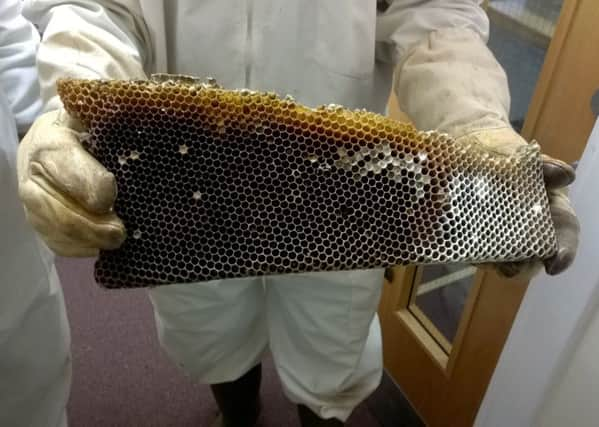Thousands of bees causing a buzz at Heriot-Watt University


The colony of 5000 bees was found producing honey in a wall cavity in the library at Heriot-Watt University’s Riccarton Campus.
The insects were able to get in and out via a study room on the third floor of the building, which is currently being renovated.
Advertisement
Hide AdAdvertisement
Hide AdExperts from the Scottish Bee Keepers Association safely relocated the bees to an apiary a few miles away, where they will be kept to make blossom honey.
The university is now looking at establishing a managed colony on the roof of the library, which is currently undergoing a major refurbishment.
Professor John Sawkins, deputy principal learning and teaching said: “With honey bees currently in decline we were only too happy to work with the Scottish Bee Keepers Association to find the insects a new home.
“We’re currently refurbishing our library, and we wanted to make sure that the bees were handled with care as we know how important they are to the environment.
Advertisement
Hide AdAdvertisement
Hide Ad“It was quite a large colony that was found and some of the cells were producing honey. The bee population currently have a mite problem, but our bees showed no sign, so they obviously enjoyed their home on campus.
“With spring fast approaching we’ll continue to work with the bee keepers to make sure these declining species are kept safe and have the best possible environment to thrive in.”
As part of the library renovations, cavities and gaps used by the bees were being filled in, which would have resulted in the bees being trapped inside the building. Rather than harm the bees, the university called experts to safely remove them.
The bees were located using cameras inserted in to the walls, then vibrations were created to disturb them. The experts were then able to remove panels and start to cut out the comb with the bees before placing it in a hive. Once the worker bees were clustered around the queen they were transported to their new home.
Advertisement
Hide AdAdvertisement
Hide AdTests showed the bees were healthy, with no signs of a varroa mite that has affected many Scottish colonies.
Edinburgh bee keeper Andy Anderson, 59, who has adopted the insects, said the discovery came as a shock. He said: “We are accustomed to being called in summer to deal with swarms of bees, but to be asked in February to remove an established colony of bees from a library is a first.
“We think the colony started as a swarm from a managed colony somewhere near the university, and decided to make the library their new home. From the size of the nest and the amount of comb they had produced it looks like they had been there at least 18 months. The library staff were able to take some of the honey away with them.”